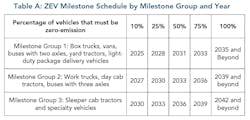Environmental groups push CARB to accelerate ‘clean fleet’ timeline
A study commissioned by two environmental groups says accelerating California's Advanced Clean Fleets rule by four years would lead to 130,000 more clean trucks on the road by mid-century. The California Air Resources Board is set to begin accepting public comments on the fleet rule proposal Sept. 2.
The independent report by Environment Research Management for the Natural Resource Defense Council and Union of Concerned Scientists found that moving the clean fleet rule's 100% zero-emission truck sales target from 2040 to 2036 would also produce "net societal benefits of $9.9 billion" between 2022 and 2050. Those savings would come from reduced pollution, improved air quality, higher utility net revenue, and fleet savings, according to the study released on Aug. 31.
See also: Cummins is finding more than one way to decarbonize fleets
CARB is working to finalize this year the Advanced Clean Fleets regulations it has been developing since 2020. Its goal is to transform the Golden State's medium- and heavy-duty diesel and gasoline fleets to zero-emission vehicles by 2040. CARB is opening up public comments on the draft regulations from Sept. 2 to Oct. 17, in advance of a public hearing on Oct. 27.
"Families all across California are suffering from the impacts of environmental racism that come in the form of living in some of the most polluted communities in the country," said Andrea Vidaurre, a policy analyst with the People's Collective for Environmental Justice. "CARB has a responsibility to maximize and accelerate the benefits identified in this report to those families to ensure that the Advanced Clean Fleet rule reflects this critical need across the state."
California's proposed Advanced Clean Fleets rules
According to the proposal, truck OEMs would be required to only sell zero-emission medium- and heavy-duty vehicles starting in 2040. But before that, CARB wants to limit how many non-ZEVs fleets can procure. The draft rules put vehicle requirements into three fleet categories: High priority and federal, drayage, and state and local government fleets.
High priority and federal fleet vehicle requirements:
Carriers that earn more than $50 million in gross revenue, own, operate, or direct at least 50 vehicles; or operate for a federal agency. Vehicles with a GVWR over 8,500 lb. would have to meet CARB's standards. Fleets would have two ways to comply with the proposed regulations: vehicle additions or percentage milestones.
Fleets that choose the ZEV additions route would not be permitted to add more diesel, gasoline, or natural gas trucks to their fleets starting in 2024. Depending on the makes and models, they would also be required to remove older internal-combustion engine vehicles from their fleet once those trucks reach a certain age.
The percentage milestones option allows fleets to calculate a ZEV requirement compliance percentage. It will enable fleets to add diesel-, gasoline-, and natural gas-powered trucks so long as they meet milestone obligations.
Drayage fleet vehicle requirements:
Starting in 2024, CARB wants drayage fleets will only be able to add zero-emission trucks. According to the draft regulations, legacy vehicles operating with traditional internal combustion engines must be removed from operation. CARB calls for all drayage trucks operating in the state to be zero-emission by 2035. California's Drayage Truck Registry will regulate what vehicles can enter ports and intermodal sites.
Government fleet vehicle requirements:
State, local, county, and other non-federal government fleets would be required to purchase at least 50% ZEVs beginning in 2024, according to the draft regulations. By 2027, all new vehicle purchases would have to be zero-emission.
Environmental groups push for faster ZEV timeline
Environmental justice, health, and labor proponents in California are backing the accelerated clean fleet target by four years from 2040 to 2036, according to the groups behind the Environmental Research Management study.
Before Labor Day weekend, California utility operators said the state's energy grid could be strained during a heat wave and asked residents not to charge EVs. This came a few days after CARB announced another proposal to end the sale of gasoline-powered cars.
See also: Trade group withdraws lawsuit against CARB
The report from ERM that wants CARB to speed up statewide truck conversions to ZEVs does not address the external resources needed to convert fleets sooner. But it does note that utility companies would make more revenue on an accelerated timeline. But to increase charging infrastructure for battery-electric trucks would require billions of dollars in fleet, government, and private investments over the next 25 years.
Under the "100% Sales by 2040" scenario, California's fleet owners would need to invest an average of $159 million per year (in 2020 dollars) between 2025 and 2050 to purchase and install depot-based charging infrastructure, according to the new study. In addition, government and private investors would need to invest an average of $296 million per year over the same period to build out a publicly accessible charging network across the state to serve the battery-electric medium- and heavy-duty fleets.
Under the "100% Sales by 2036" scenario, the study said fleet investments in depot charging infrastructure from 2025 to 2050 would need to average $177 million per year, and public and private investments in the public charging network will need to rise to an average of $303 million per year.
The study says this accelerated investment and cleaner air would be worth it because there would be 130,000 more Class 2b to Class 8 electric trucks on the road in 2050. It projects that would result in more than $30 billion in health care savings. It also contends that the EVs would save fleets between $48,000 and $84,000 in fuel and maintenance costs over a vehicle's lifetime. It would also cut climate pollution by 24 million metric tons.
CARB will hold a public hearing Oct. 27 on the proposed Advanced Clean Fleets regulations.
About the Author
Josh Fisher
Editor-in-Chief
Editor-in-Chief Josh Fisher has been with FleetOwner since 2017. He covers everything from modern fleet management to operational efficiency, artificial intelligence, autonomous trucking, alternative fuels and powertrains, regulations, and emerging transportation technology. Based in Maryland, he writes the Lane Shift Ahead column about the changing North American transportation landscape.



